Do-it-yourself septic tank without pumping and odor: simple solutions for your garden
A cesspool is the simplest, but not too successful variant of an autonomous sewage system in a private house. Modern technologies offer more convenient solutions, for example, local treatment plants of industrial production.
A skilled builder is quite capable of making a septic tank with his own hands without pumping. What options for odorless septic tanks are popular among owners of private houses and what is required for their construction - all this we will consider in our article.
We also give an example of assembling a septic tank from concrete rings and compare the ready-made solutions offered by the market with homemade products.
The content of the article:
The principle of the treatment plant
Septic tanks are called sewer structures that almost completely process waste water, decomposing them into safe components.
All work on the conversion of human waste is assigned to microorganisms. Aerobic and anaerobic bacteria that are not appetizing drains are gradually processed into water and activated sludge.
Aerobic bacteria can work only in the presence of oxygen, but anaerobic microorganisms successfully perform work in sealed containers.
Such a vessel reliably cuts off unpleasant odors of drains, but in order to connect aerobic microorganisms to work, it will be necessary to organize forced injection of air into the septic tank.
In practice, such a sewage treatment system consists of several containers or compartments.
And the whole processing process can be divided into several main stages:
- Primary stockpiling, separation of contaminants that are not biodegradable.
- Processing the remaining effluents with bacteriaas a result of which the contents of the septic tank decompose into water and neutral sludge.
- Post-treatment and sedimentationduring which sludge accumulates at the bottom in the form of sediment.
- Disposal and disposal of treated wastewater.
All this takes time. Wastewater gradually moves from one section of the septic tank to another through overflow openings or special pipes.
The sludge obtained as a result of biological processing of the contents of the sewage system is called neutral or active.
Both names can be considered correct. This mass is neutral because it is not harmful to the environment.
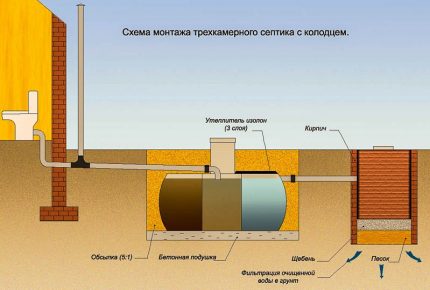
Moreover, sludge can be used on site as a useful fertilizer for plants. This sludge is called active due to the fact that part of the bacteria is contained directly in this mass.
Microorganisms that process wastewater reproduce themselves in the cleaning process. For this reason, there is no need to constantly introduce them into the septic tank.
With improper use of such a device, the number of bacteria inside can dramatically decrease. This happens if aggressive substances that destroy microorganisms enter the sewer uncontrollably.
This applies, for example, to chlorinated preparations, certain antibiotics, industrial oils, cleaners, etc.

Another common cause of death of microorganisms in a septic tank is the improper preservation of the device for the winter. Some owners confuse a septic tank with a heating system and completely empty it for the winter.
This is wrong, the device must remain partially filled, even if it is not used, in order to maintain a suitable environment for bacteria to live.
More detailed information on the types and operation of aerobic and anaerobic bacteria is available in this article.
If the device is insulated and properly preserved, it is not afraid of either winter frosts or spring floods. It will not float or crack, even if part of its contents freezes.
It is important, of course, to correctly install the device. In the process of wastewater treatment, bacteria effectively eliminate the smell characteristic of the sewage system.
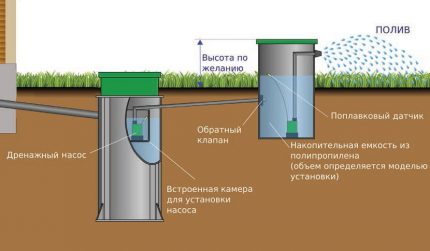
The resulting water, of course, is not suitable for drinking, cooking, washing or other household needs. With a high degree of purification, it can be used to water plants on the site.
Often water is removed through a filtration well or filtration field. Water gradually enters the ground, passing through a cleaning system, a layer of sand and gravel.
Sludge that settles at the bottom of a sealed container, of course, does not disappear. It accumulates, as a result of which the total volume of the septic tank decreases slightly. When the amount of deposits becomes critical, the device should be cleaned with a special pump.
Cleaning the septic tank is performed much less frequently than pumping out a cesspool, and this process is usually not accompanied by stench, since sludge has a completely neutral smell.
We recommend that you familiarize yourself with rules for cleaning the septic tank and the features of its preparation for the winter period of operation.
Comparison of VOCs and homemade septic tanks
It is relatively easy to get a septic tank, you can just buy it. Modern VOCs - local treatment plants - are high-performance devices that are reliable and easy to maintain.
It can be a relatively compact unit, inside divided into overflow compartments. Sewage treatment in such units is carried out by settling without the participation of technical devices.
If the units are highly biological treatment systems, they are equipped with pumps and aeration systems for oxygen supply. The indicated option depends on energy supply.
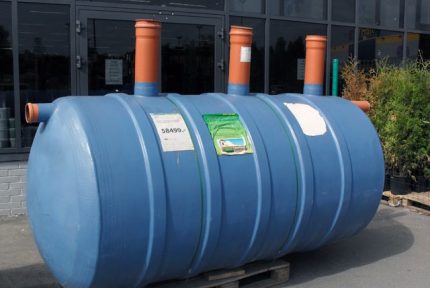
As a rule, bioremediation stations are already insulated and equipped with a reliable sealed cover. VOCs that produce a high degree of purification are equipped with compressors that pump air into the device and perform active aeration of the effluents.
This allows the use of both aerobic and anaerobic bacteria in the effluent processing process, decomposing more than 95% of all effluents.
But all such devices have significant drawbacks - high price and dependence on the availability of electricity necessary for the operation of technical equipment.
Variants of overflow septic tanks for industrial production, in which no compressors are provided, are quite inexpensive and quite suitable for price and wear resistance for the arrangement of a summer cottage.
But such models, in fact, are a modernized version of the cesspool. The degree of purification here reaches only about 60 - 70%, water is suitable only for technical use after carrying out soil post-treatment in an absorption well or filtration field.
More detailed information on existing types of septic tanks, the principle of their work and recommendations on choosing the most suitable option for your needs given here.
All this encourages the owners of private houses to independently build a septic tank, which does not need to constantly remove drains. This is not to say that this is a simple and easy job, but if the master has experience, for example, building his own well, then he will completely cope with the creation of a home-made septic tank.
For money it will come out clearly cheaper than the acquisition of VOCs. And the result will be significantly better than using a conventional cesspool.
To make a septic tank, you need to choose a place, dig one or more pits, build sealed containers in them, connected by overflows, make a filter well, etc. No extra complicated equipment or special building skills are needed.
Nuances of designing an autonomous sewer
First, you should draft a new structure and find a suitable place for it on the site. The volume of a septic tank for giving without pumping is not difficult to calculate. To do this, multiply the number of people who constantly live in the house by 200 liters. This is a typical rate of water consumption per person per day.
The resulting figure needs to be increased by another 20%. The result will be the desired volume of the septic tank. Distribute this volume as follows: 25-30% of the volume is diverted to create a filtration well, and the rest is in the main compartment or compartments of the septic tank. The parameters of the septic tank depend on its configuration.
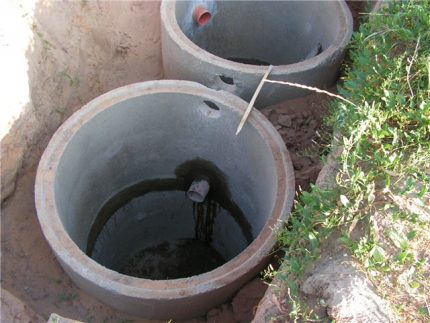
The volume of the cubic tank is calculated as the product of length, width and height. If the container is cylindrical, then to calculate its volume, multiply the height by the area of the base. The circle area formula is well known from the school geometry course: the product of the square of the radius and the number pi.
When determining the parameters of the tank, it should be remembered that the distance from the bottom of the septic tank to the place of entry of the sewer pipe should be 80 cm or more. In this case, the slope of the pipe must be taken into account.
When choosing a place for a septic tank, it is recommended to adhere to the following sanitary standards:
- a distance of at least 10 meters from residential buildings and water mains;
- a distance of at least 30-50 meters from sources of drinking water;
- more than 3 meters to fruit trees;
- more than 5 meters to the road, etc.
The larger the volume of the septic tank, the more stringent sanitary standards are presented to it. Detailed information can be obtained in the relevant sections of SNiP under number 2.04.03-85 and the regulations SanPiN 2.1.5.980-00defining rules for maintaining the purity of groundwater.
In addition, the level of groundwater should be taken into account, since the bottom between the conditional bottom of the ground treatment facilities and water treatment must be at least a distance of 1 m.

If groundwater runs too high, even more serious requirements are imposed on the design of the septic tank: it must be absolutely airtight.
For a home-made design in this situation, only a plastic container is suitable - a eurocube. Or it is worth giving preference to the cumulative capacity of industrial production. We recommend that you familiarize yourself with capacity selection rules for septic tank.
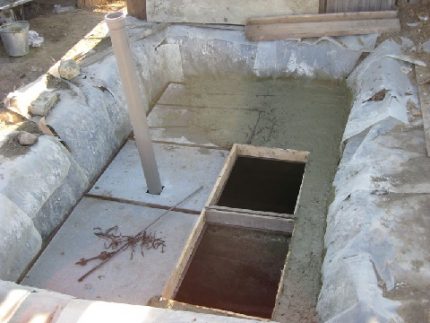
Another important point when choosing a place for a septic tank is access to transport. Although cleaning the septic tank without pumping is not often performed, the presence of special equipment can significantly facilitate this process.
How to make a septic tank from concrete rings?
One of the most popular options for a homemade septic tank is the construction of concrete rings. Ready-made concrete structures greatly facilitate the installation of the device compared to, for example, concrete pouring.
The process of creating a septic tank consists of the following steps:
- Marking the place for a septic tank.
- Digging a pit.
- Installation of concrete rings.
- Concreting the bottom of the pit.
- Connection of the sewerage and overflows.
- Sealing and waterproofing joints.
- Backfill of the pit.
- Installation of the upper floor with a cover.
But before buying the necessary components it is advisable to make septic tank diagram and deal with installation features. The following photo selection will help to visualize the process of building a septic tank from concrete rings:
Under concrete rings, of course, you need a pit of a cylindrical shape.Such pits will need two or three, depending on the number of septic tank chambers. If it comes to servicing a small cottage, you can get by with just two cameras.
In the first, sedimentation and bacterial processing of sewage will be carried out, and in the second - the disposal of clarified wastewater through a sand and gravel filter.
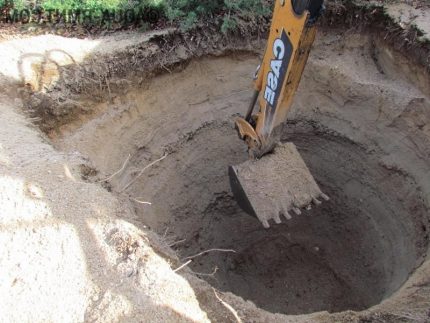
For a private house, in which several people live, it makes sense to build a three-chamber structure. The first two chambers will be almost identical in design.
The first is the insert of a sewer pipe leading from the house. The distance between the individual parts of the septic tank should be about 50 cm.
The depth of the pits is determined by the height of the rings and the thickness of the bottom, although in the last pit, concreting of the bottom is not necessary.
For earthworks, you can use an excavator or carry them out manually, although this is a rather time-consuming method. On dense clay soils, you can first dig a pit, and then install rings in it.
On sandy soils, rings are usually put in the chosen place and soil is selected from the inside of the circle so that the ring gradually drops down.
Then set the next ring, etc. This method is very effective in the construction of wells, but septic tanks are usually not so deep, so you can choose the most convenient method.
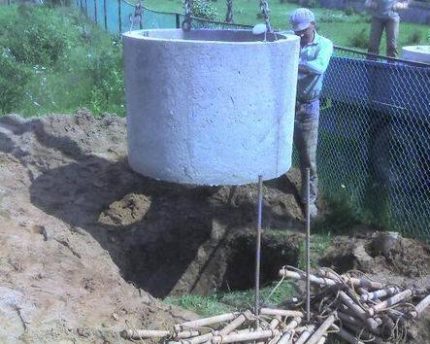
The pit is dug, the rings are lowered, now you can start concreting the bottom. To do this, use a mixture of cement, sand and water in a ratio of 2: 2: 1. The composition is poured to the bottom of the structure. Before using the septic tank, you need to wait for the screed to dry, this will increase its strength.
The joints between the rings are sealed inside and out using cement mortar. It is recommended to use dry building mixes, which are intended for use in places with high humidity. After sealing the joints they are treated with waterproofing.
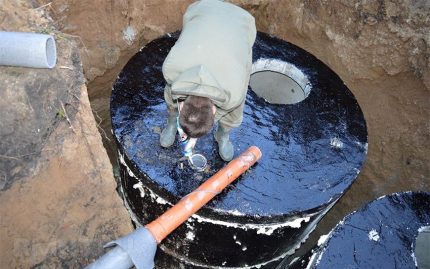
A trench for the sewer pipe leading from the house to the septic tank without pumping and odor is laid with a slight slope. At the junction of the septic tank and the pipe, a hole of suitable size is made in the thickness of the concrete.
In the same way, overflow pipes are installed that connect the individual parts of the septic tank. All the junction of the septic tank with pipes must be repaired and covered with a layer of waterproofing.
Instead of cement mortar, a gravel-sand filter is placed at the bottom of the last section of the septic tank. First, sand is poured and leveled, and then a layer of gravel.
It is also allowed to use crushed stone of a suitable fraction for these purposes. The thickness of the filtration layer should be approximately 30-40 cm.
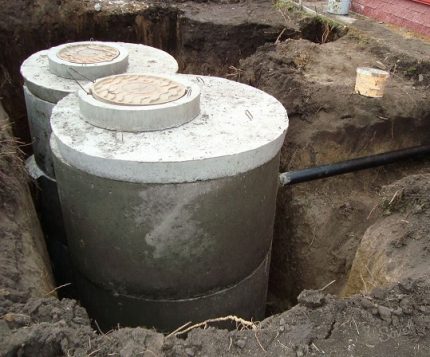
After all the septic tank compartments are ready, you need to cover them with round concrete slabs, which can be purchased from the manufacturers of reinforced concrete products complete with concrete rings.
These covers have openings with sealed concrete covers. It remains to backfill the pits, and the septic tank can be considered ready for operation.
Other options for homemade septic tanks
In addition to concrete rings, other materials can be used to create a septic tank. Consider the most popular materials and septic tank manufacturing options.
Option # 1 - a septic tank from a eurocube
The eurocube, a sealed plastic container, has already been mentioned.
It is relatively not difficult to install such a septic tank, but the low physical weight of the plastic should be taken into account. During a spring flood, groundwater can simply push a light tank to the surface.
To weight such a septic tank, a concrete slab with metal loops should be laid at the bottom of the pit. To these loops, the capacitance is fixed with a metal cable. Sometimes such a septic tank is weighted with the help of some heavy object, which is fixed at the top of the device.
We recommend that you read the step-by-step assembly guide. eurocube septic tank.
Option # 2 - monolithic concrete structure
Concrete septic tank can be made using pouring. In this case, it is not necessary to make several pits, you can do with one large-size structure and a rectangular configuration.
First, the bottom is concreted, then the formwork is installed and the walls of the septic tank are poured. To divide a large capacity into several sections, concrete walls are made inside.
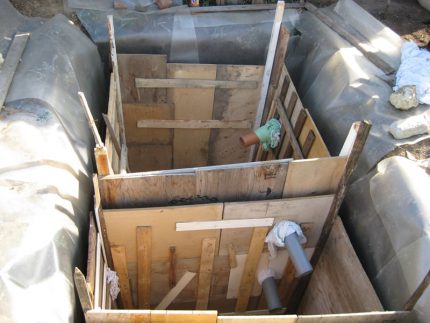
They then perform holes that play the role of overflows. On top of such a septic tank is closed with a concrete slab with a hole for the lid. A tight, but large enough lid should be in any septic tank. It is necessary to perform maintenance on the device.
Are you interested in this type of septic tank? We recommend that you consider the manufacturing process in more detail. monolithic concrete septic tank.
Option # 3 - brick septic tank
In the same way, a septic tank is made of brick. The bottom is concreted, the walls are erected using brickwork, and a concrete slab is placed on top. From the inside, such a septic tank does not hurt to handle waterproofing. It should be understood that not any design of this type can be considered a septic tank.
A septic tank can be made with your own hands from concrete blocks or bricks, but the masonry should be as tight as possible.
Another option is to make septic tank from old tires. However, such material cannot provide sufficient tightness to protect the soil from untreated effluents.
Using tires, you can only make a permeable cesspool option. The life of such a device is significantly limited, unlike a major septic tank, which with proper maintenance can last for decades.
Conclusions and useful video on the topic
This video details the option of creating a two-chamber septic tank:
Of course, a homemade septic tank does not always provide the same high degree of purification as modern VOCs. But still, these structures operate very successfully with relatively low costs for their installation and maintenance.
When constructing a septic tank, it is important to adhere to technical standards to prevent pollution of groundwater.
Do you use a homemade septic tank without pumping? Tell us, what type of building did you prefer and does your family have enough of its volume? How often do you clean and what measures do you take to prepare your septic tank for winter?
Leave your comments under our article - your experience in the construction and operation of a home-made septic tank will be useful to many owners of private houses and cottages.

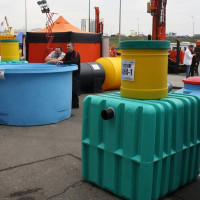 Budget septic tanks for giving without pumping: the best manufacturers of septic tanks without pumping in the market
Budget septic tanks for giving without pumping: the best manufacturers of septic tanks without pumping in the market 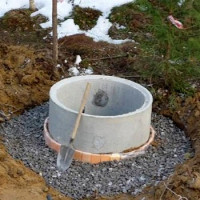 How to make a septic tank out of rings with your own hands: schemes and options + step-by-step instructions
How to make a septic tank out of rings with your own hands: schemes and options + step-by-step instructions  Do-it-yourself monolithic concrete septic tank: schemes and rules for arranging a concrete septic tank
Do-it-yourself monolithic concrete septic tank: schemes and rules for arranging a concrete septic tank 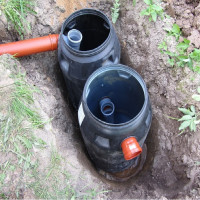 How to make a septic tank with your own hands from barrels using plastic containers as an example
How to make a septic tank with your own hands from barrels using plastic containers as an example 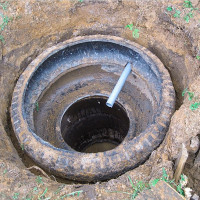 How to arrange a septic tank from tires with your own hands: step-by-step instructions
How to arrange a septic tank from tires with your own hands: step-by-step instructions 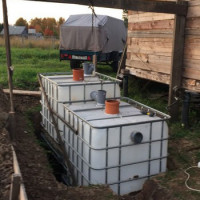 How to make a septic tank from European cubes with your own hands: step-by-step assembly instructions
How to make a septic tank from European cubes with your own hands: step-by-step assembly instructions  How much does it cost to connect gas to a private house: the price of organizing gas supply
How much does it cost to connect gas to a private house: the price of organizing gas supply  The best washing machines with dryer: model rating and customer tips
The best washing machines with dryer: model rating and customer tips  What is the color temperature of light and the nuances of choosing the temperature of the lamps to suit your needs
What is the color temperature of light and the nuances of choosing the temperature of the lamps to suit your needs  Replacement of a geyser in an apartment: replacement paperwork + basic norms and requirements
Replacement of a geyser in an apartment: replacement paperwork + basic norms and requirements
If you do not want to spend quite a lot of extra money, are full of energy and enthusiasm, then you can build a septic tank with your own hands. Currently, there are no scarce materials and ready-made structures for construction. Calculate the size and go. Deepening the rings, imagine digging a well. To mechanize the removal of soil, you can put a gate on a tripod. It is necessary to ensure complete tightness of the septic tank, there will be no leaks and soil contamination around.
Interested in the issue of calculating the volume of septic tank capacities. If in a private house there are 2 adults and two children. After all, water will be discharged by a common pipe both from the kitchen, and from the bathroom, and from the bathroom, and even a washing machine in addition. As I understand it, the drainage of “clean” water will be carried out through the second well of the septic tank, where there is no bottom. But water will not be able to leave from there instantly. And now I would like to know how capacious the wells should be so that they do not flood.
If you have a house in which 4 people live permanently, then the minimum total volume of a septic tank is 2.4 m3. It is worth counting immediately for four, the children are growing rapidly.
You have already been given the right advice about the volume of the septic tank, there can be no objection. The higher this figure, the better, plus you need to consider that in the spring this compartment will fill up faster and in season, of rains, of course.
I understand that you consider the water drain from the washing machine to be “clean”. Let me disagree with you here, since washing powder is still chemistry. I would strongly recommend mounting the water drain so that water from the washing machine gets into the sealed part of the septic tank.
And also about the speed at which the water will leave - here take into account the type of soil.